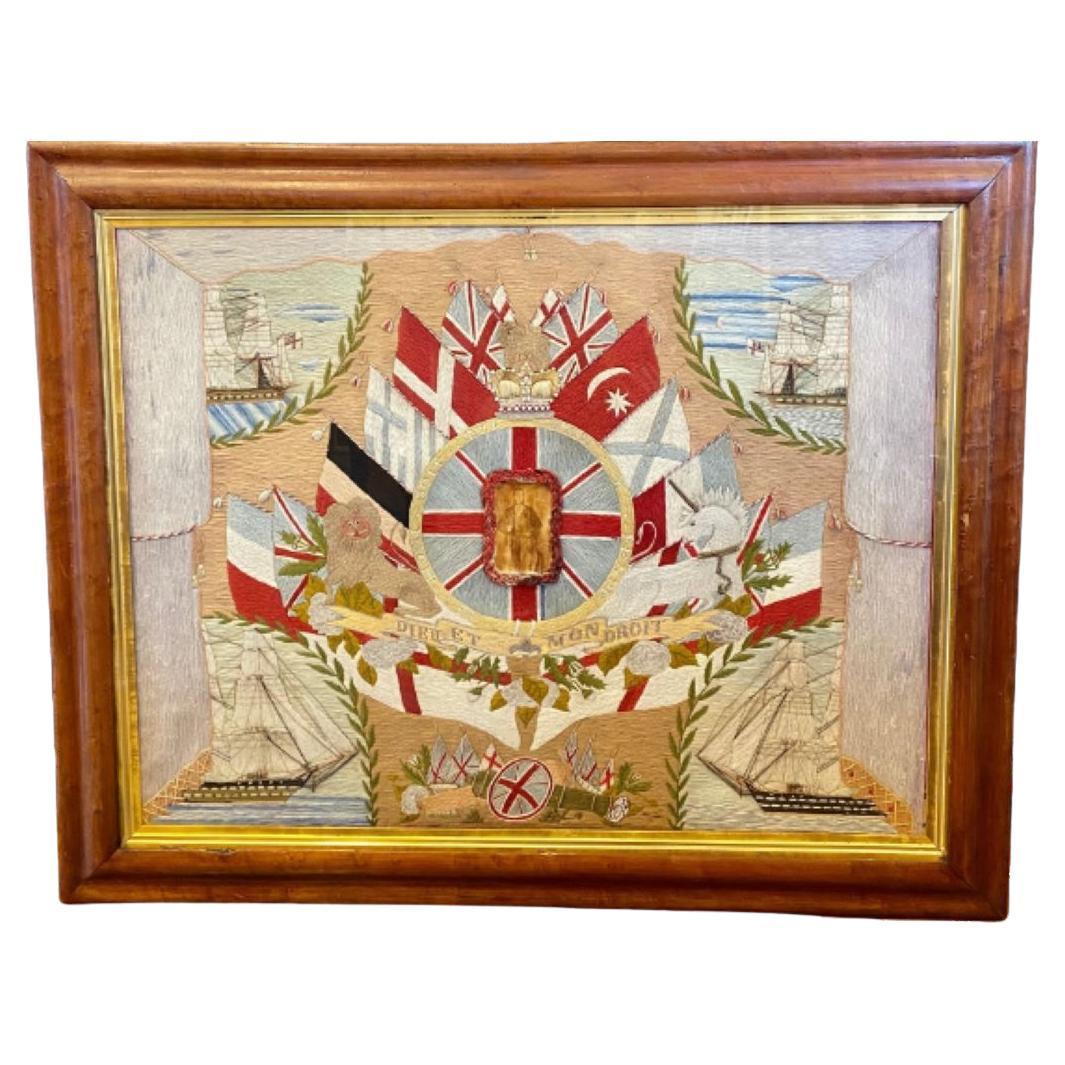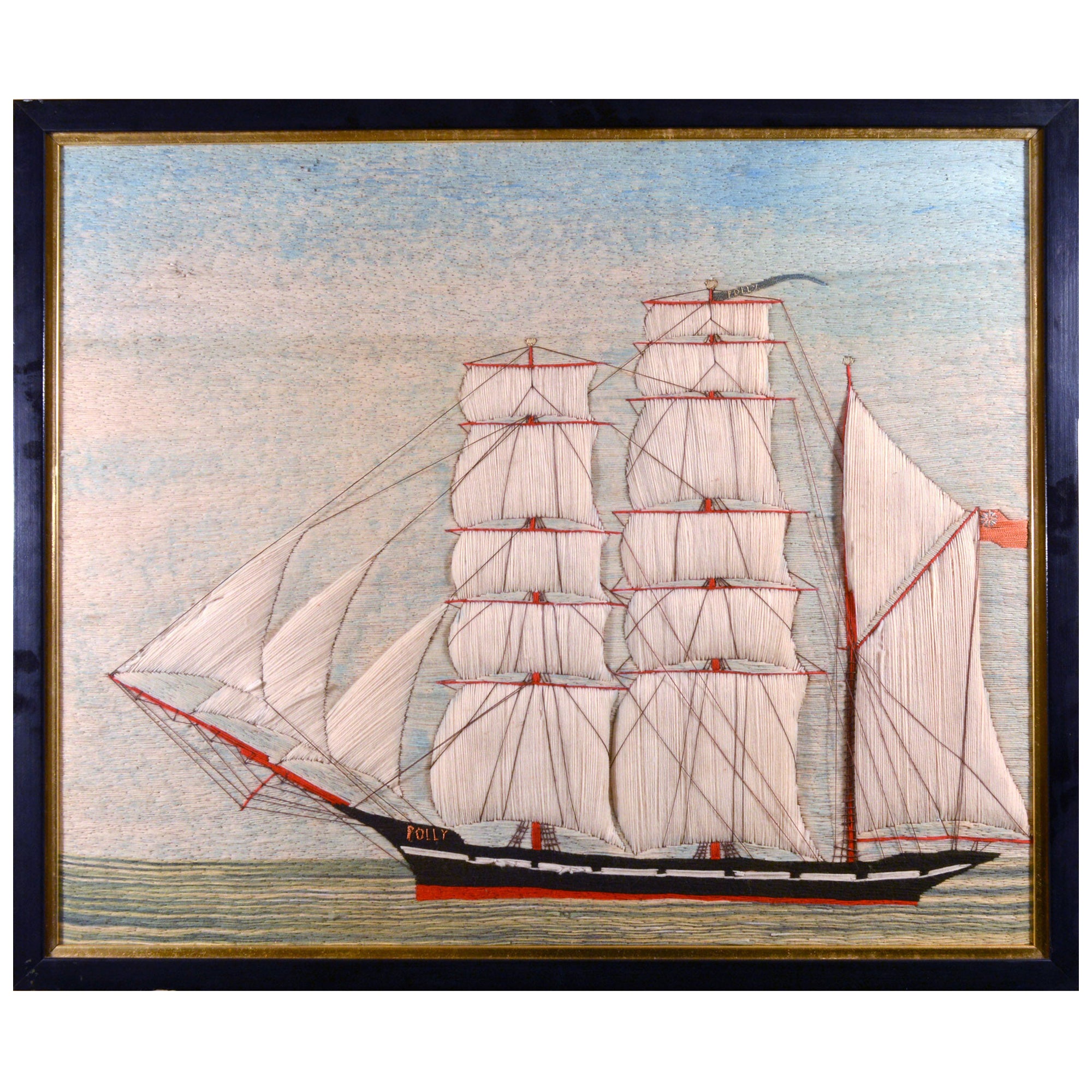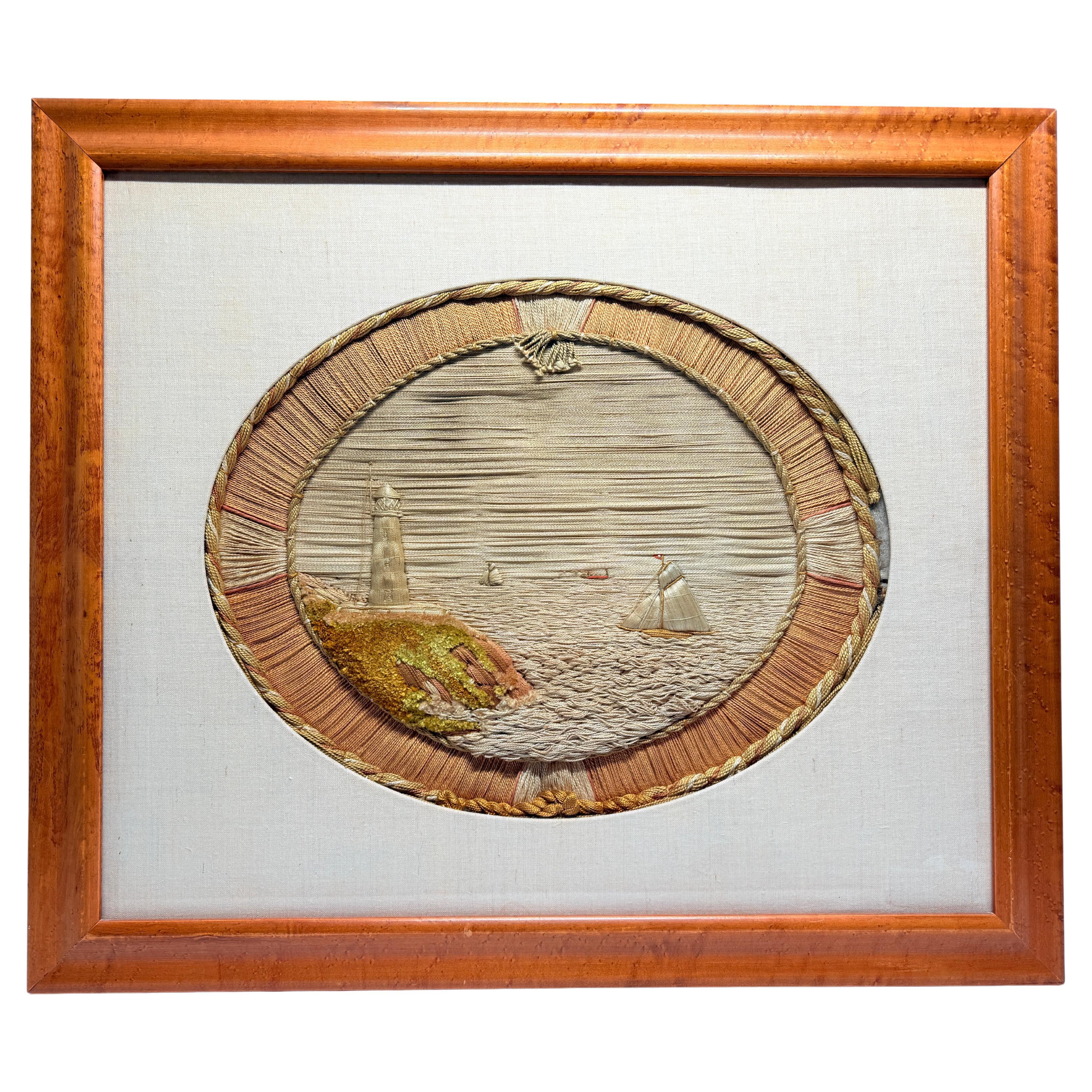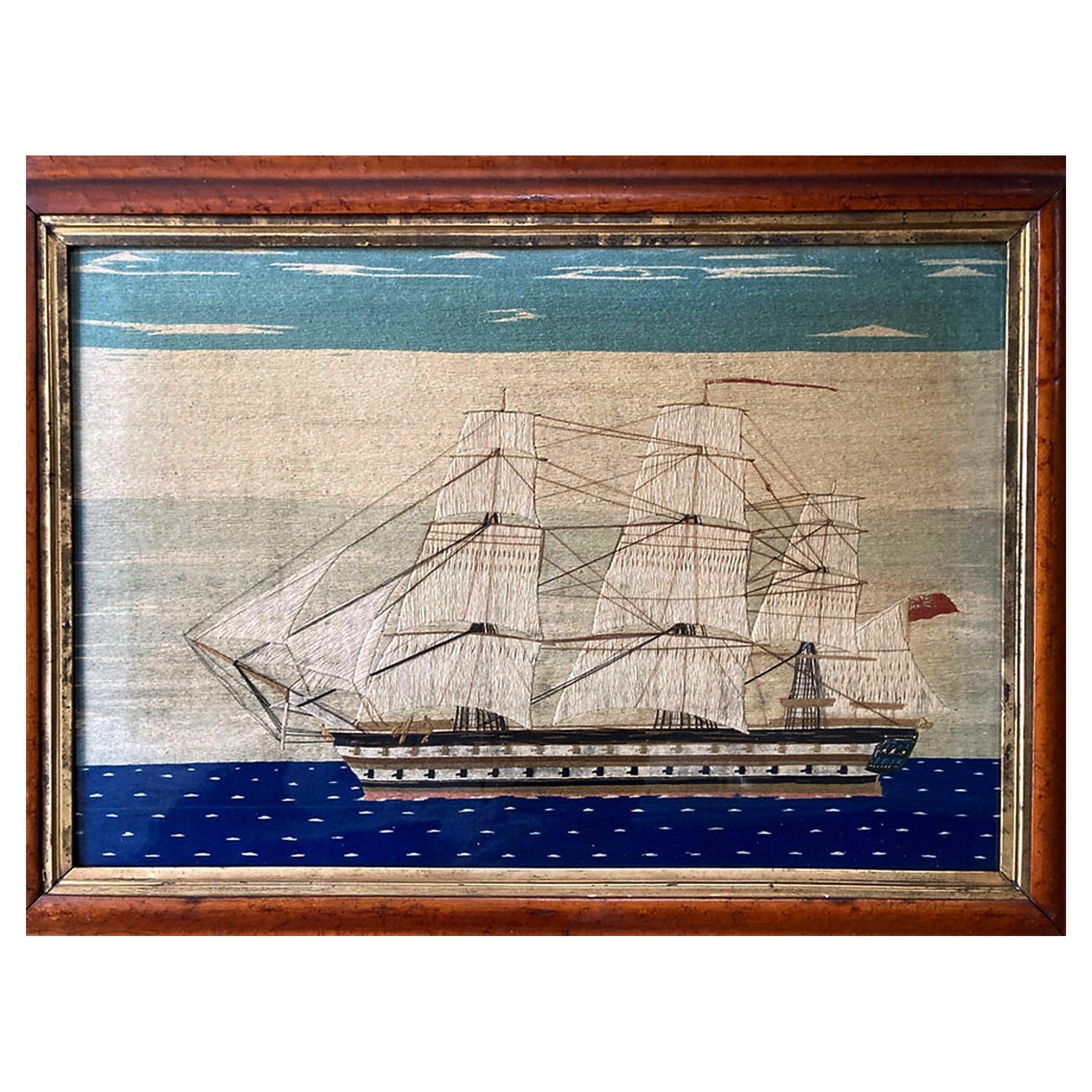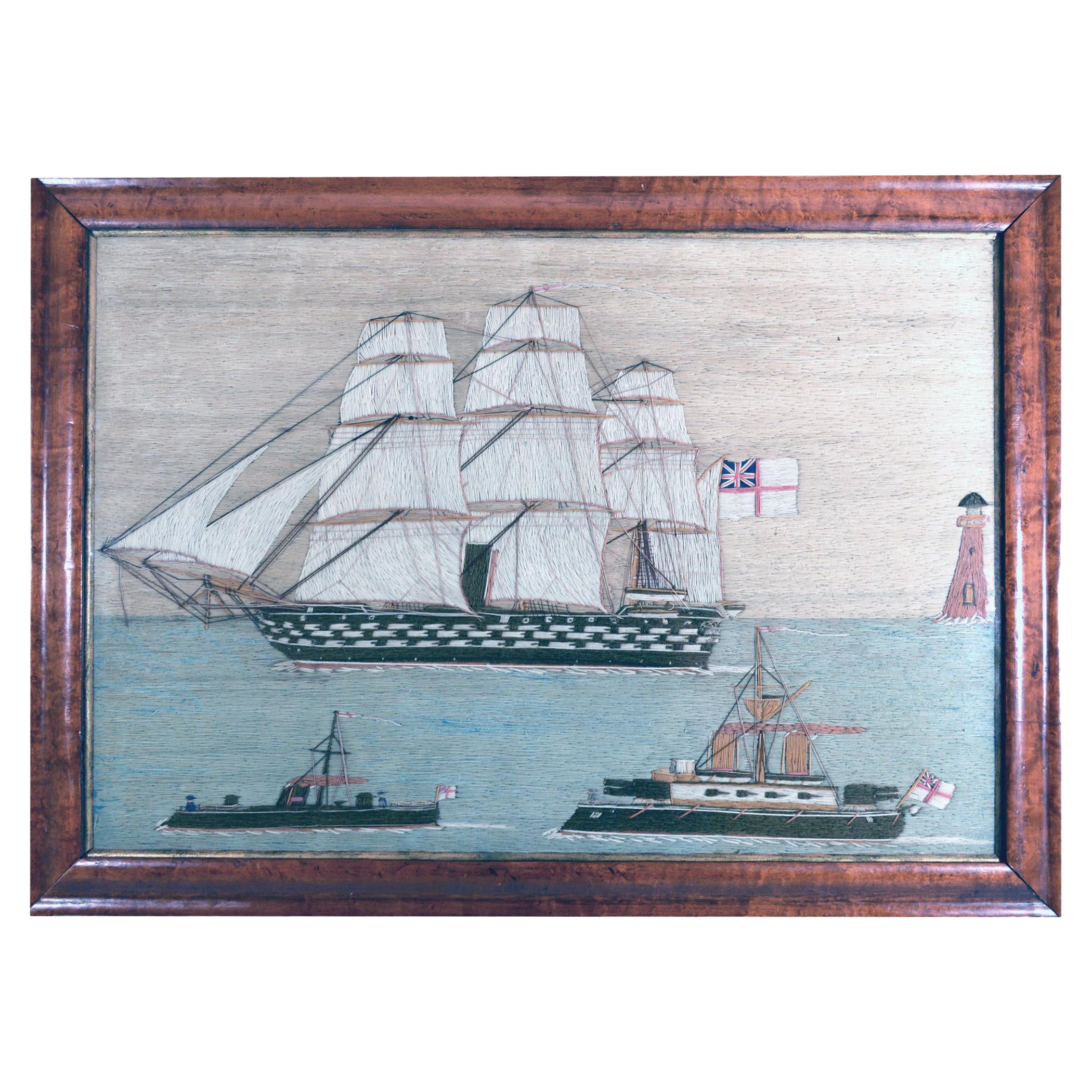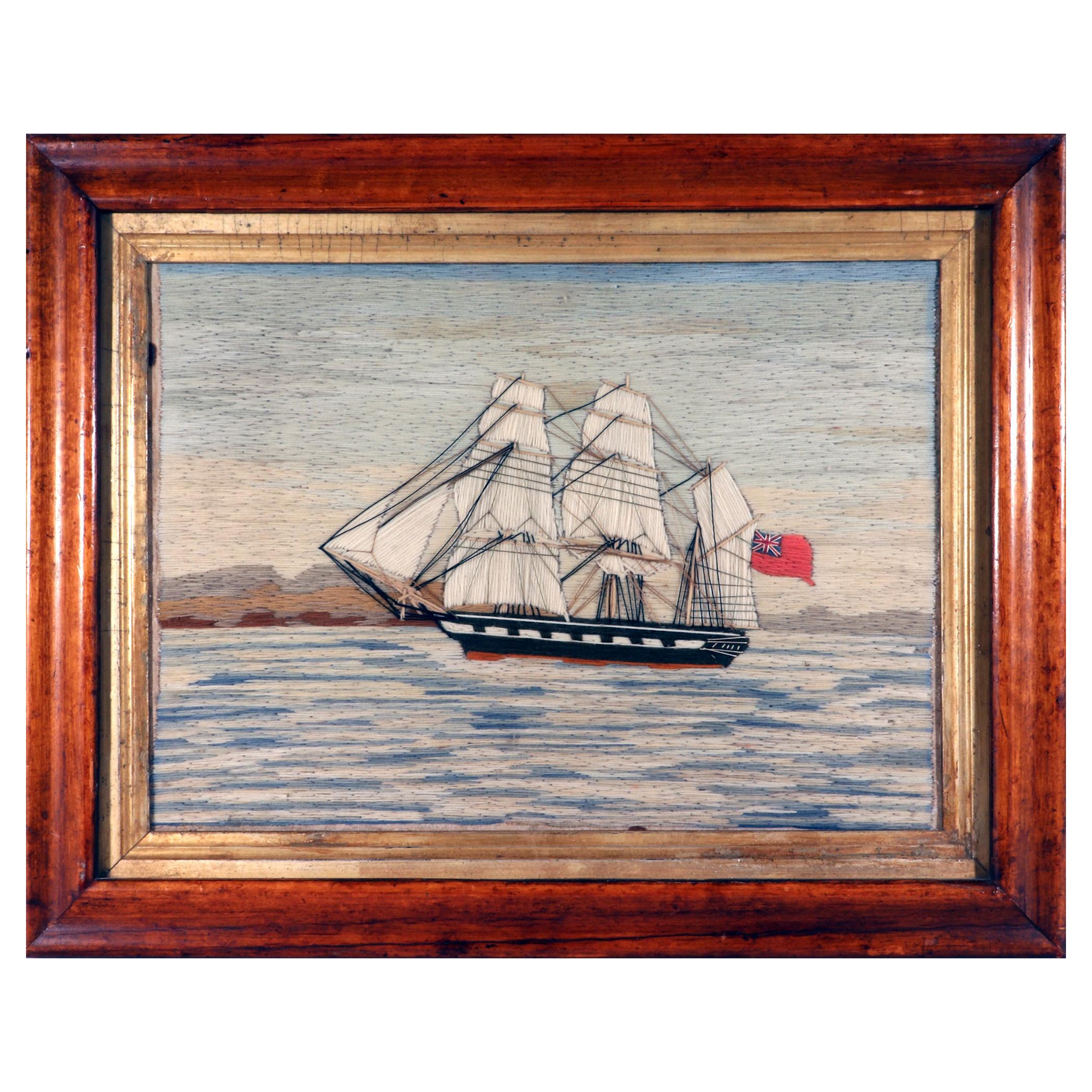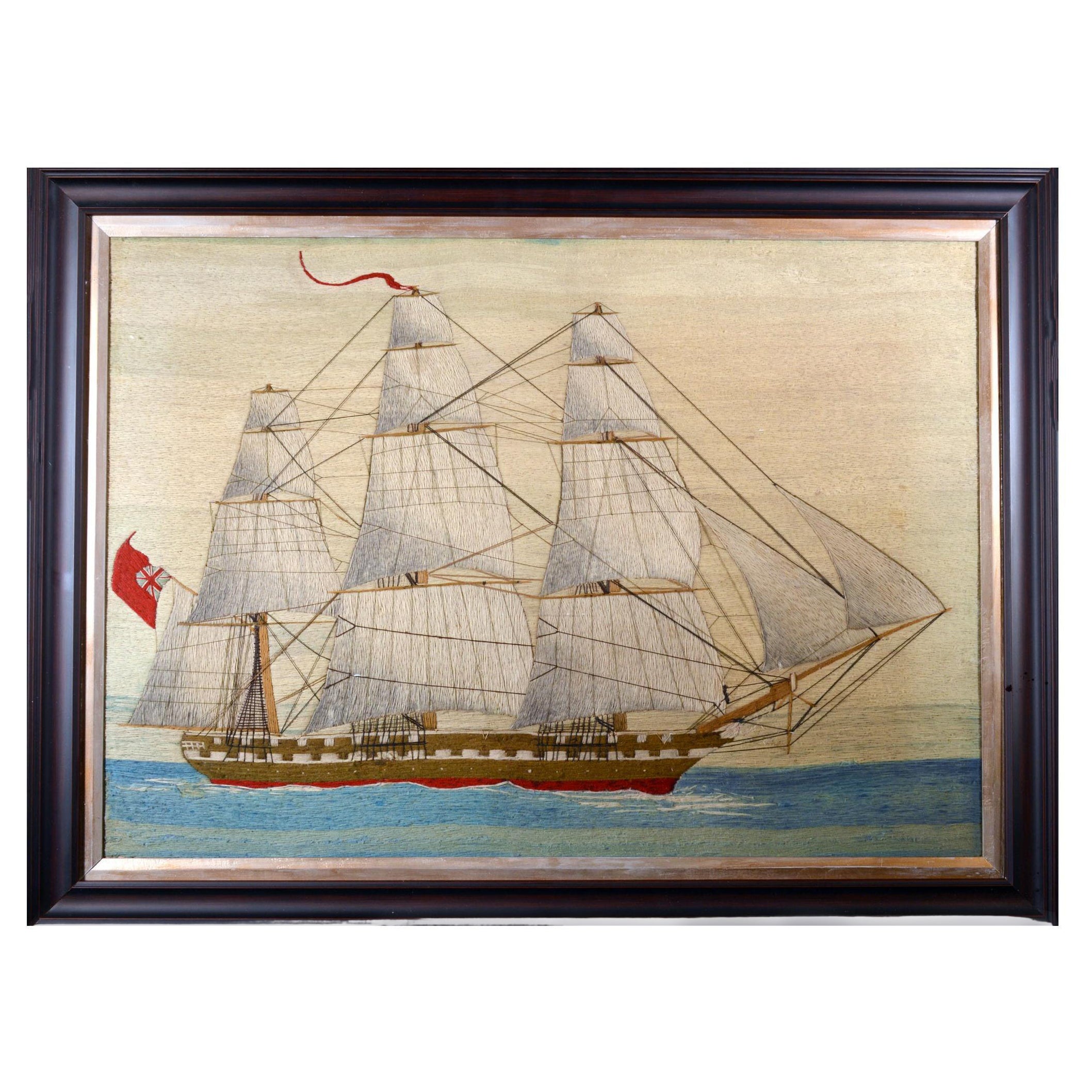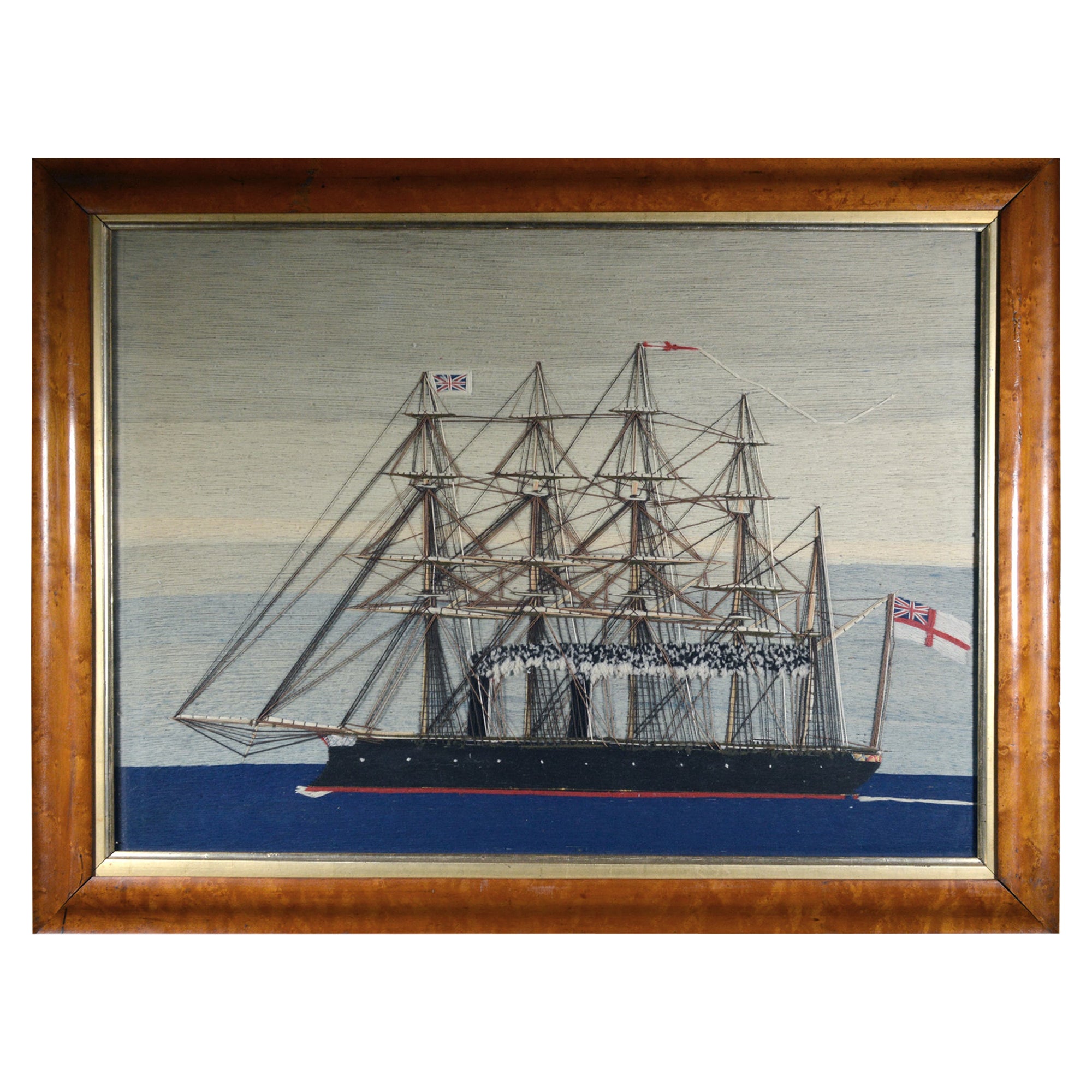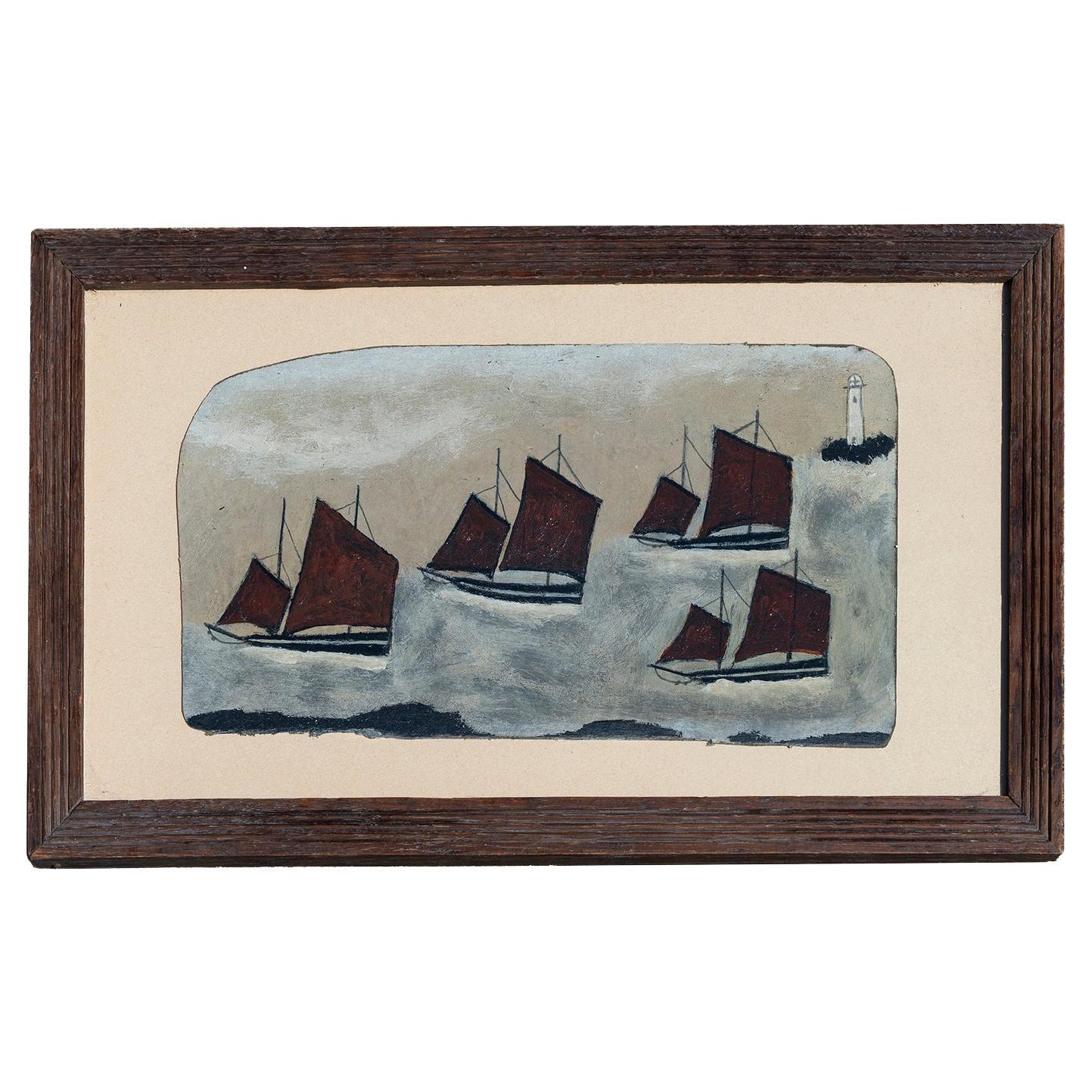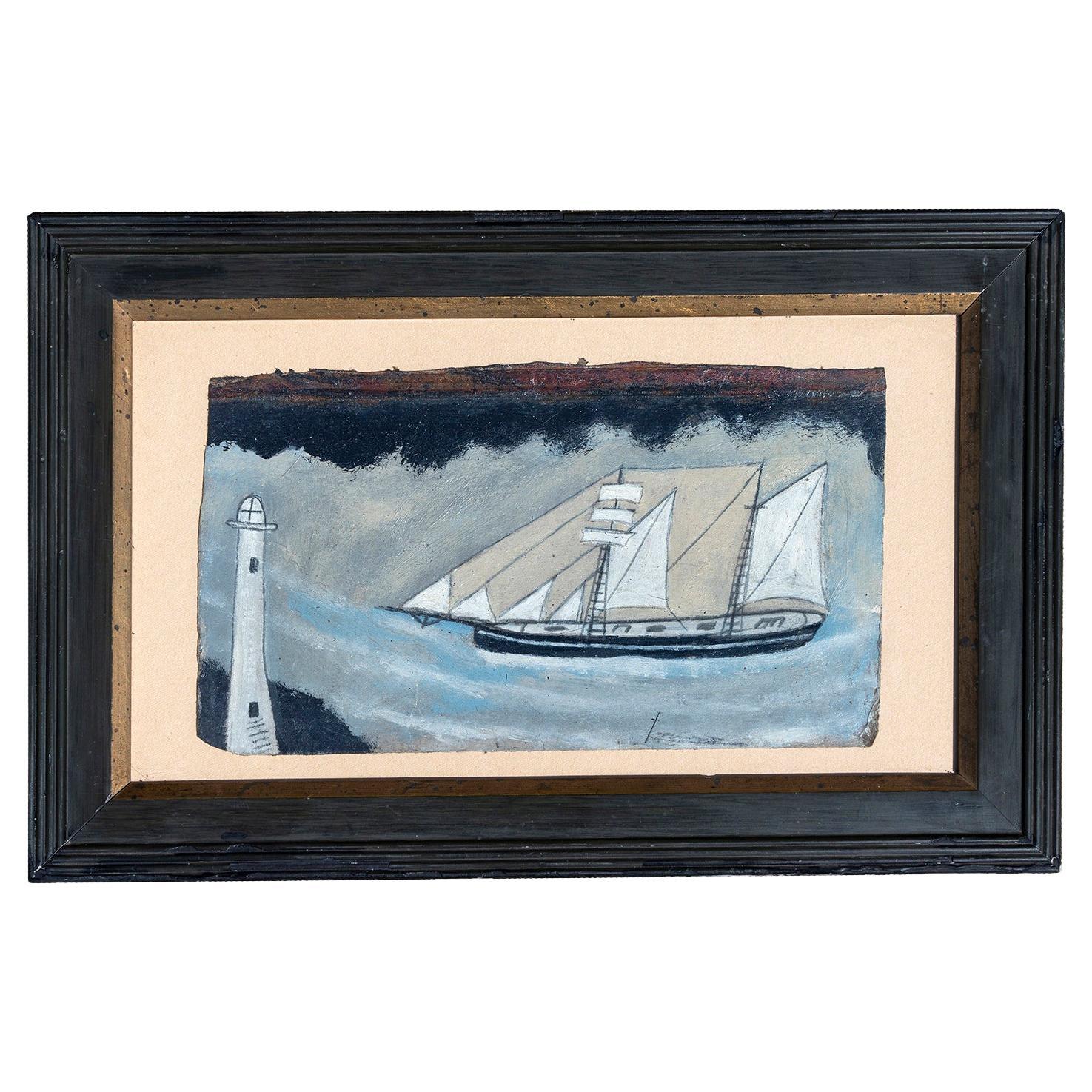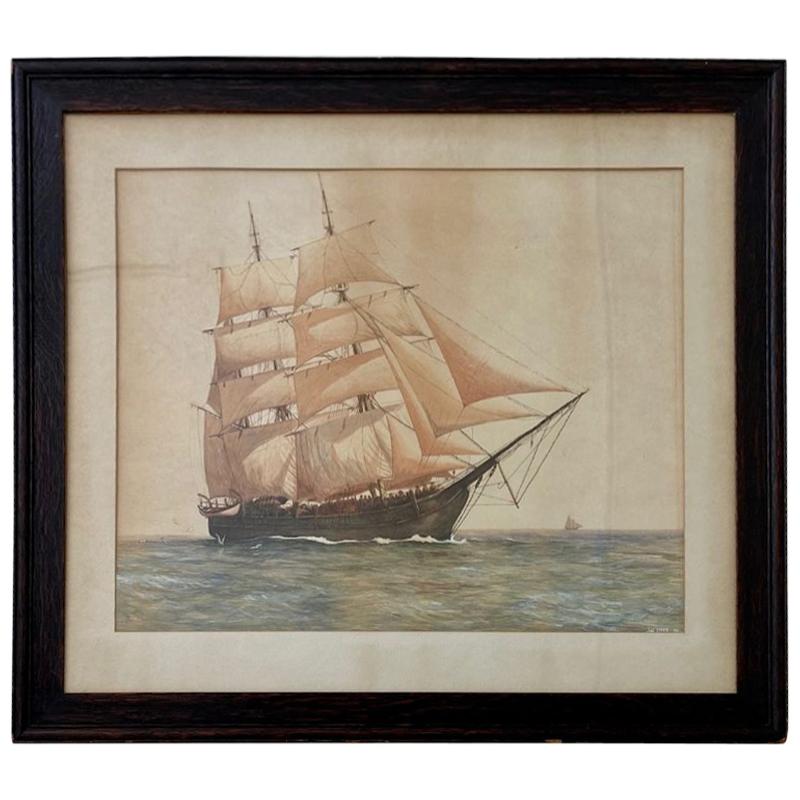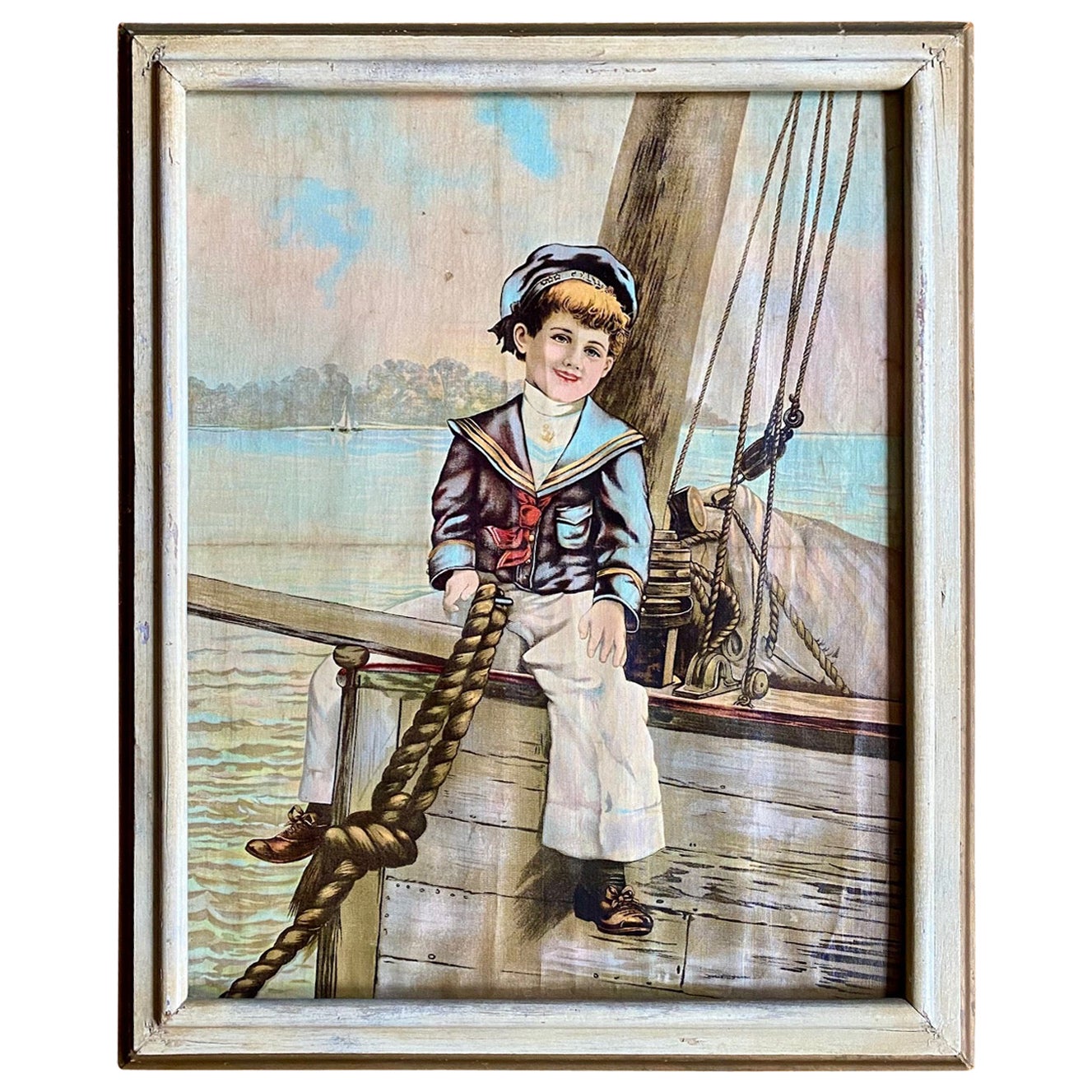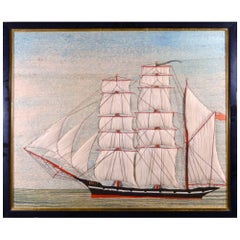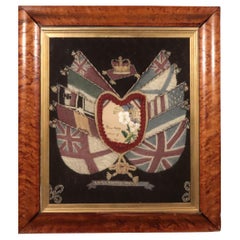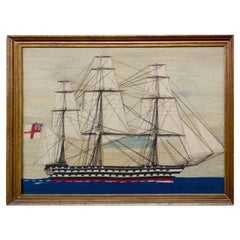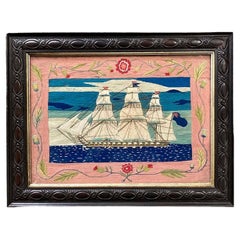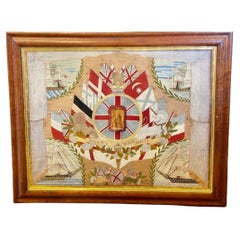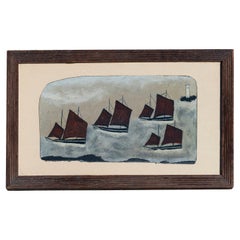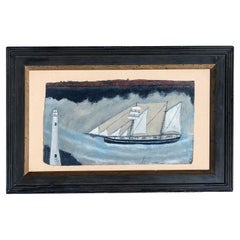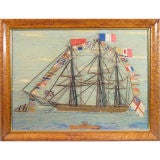
An English Sailor's Woolie of H.M.S. Tribune,
View Similar Items
Want more images or videos?
Request additional images or videos from the seller
1 of 5
An English Sailor's Woolie of H.M.S. Tribune,
About the Item
A rope ladder has been dropped off the ship's side and a launch can be seen below with figures of sailors on board. A small ship has just past the Tribune. Below the ship is a banner with H.M.S. Tribune and a crown above.
Provenance: Hunnewell Collection
The Tribune was a Corvette classified as a Frigate. She was launched on the 21 January 1853. She had a wooden hull and was 192 feet in length with a screw propulsion with a crew of 300.
Builders measure 1570 tons
Displacement 2243 tons
Guns 31
Fate 1866 Last in commission 1866
Class Class (as screw) Tribune
Ships book ADM 135/479
Career
14 January 1853 Launched at Sheerness Dockyard.
14 May 1853-- 22 November 1854
Commanded (from commissioning at Woolwich) by Captain Swynfen Thomas Carnegie, Channel squadron, then the Baltic and then the Black Sea during the Russian War.
11 December 1854
Commanded by Captain James Robert Drummond, Mediterranean, and Black Sea during the Russian War
13 August 1855
Commanded by Captain Harry Edmond Edgell, Pacific (including 2nd Anglo-Chinese War)
18 August 1858- August 1860
Commanded (until paying off at Portsmouth) by Captain Geoffrey Thomas Phipps Hornby, Pacific (where he diplomatically helped resolve the dispute - "Pig War" - with the United States over San Juan Island, off Vancover)
17 March 1862- 16 May 1866
Commanded (from commissioning at Portsmouth until paying off at Portsmouth) by Captain Viscount Gilford, Pacific.
August 1866
Sold to C. Marshall for breaking up at Plymouth.
Pig War
From Wikipedia, the free encyclopedia (http://en.wikipedia.org/wiki/Pig_War)
The Pig War was a confrontation in 1859 between American and British authorities over the boundary between the United States and British North America. The specific area in dispute was the San Juan Islands, which lie between Vancouver Island and the North American mainland. The Pig War, so called because it was triggered by the shooting of a pig, is also called the Pig Episode, the San Juan Boundary Dispute or the Northwestern Boundary Dispute. The pig was the only "casualty" of the war, making the conflict essentially bloodless.
The Oregon Treaty of June 15, 1846 resolved the Oregon boundary dispute by dividing the Oregon Country/Columbia District between the United States and Britain "along the forty-ninth parallel of north latitude to the middle of the channel which separates the continent from Vancouver Island, and thence southerly through the middle of the said channel, and of [Juan de] Fuca's Straits, to the Pacific Ocean."
However, there are actually two straits which could be called the middle of the channel: Haro Strait, along the west side of the San Juan Islands; and Rosario Strait, along the east side.
In 1846 there was still some uncertainty about the geography of the region. The most commonly available maps were those of George Vancouver, published in 1798, and of Charles Wilkes, published in 1845. In both cases the maps are unclear in the vicinity of the southeastern coast of Vancouver Island and the Gulf Islands. As a result, Haro Strait is not fully clear either.
In 1856 the US and Britain set up a Boundary Commission to survey the international boundary. Since the boundary around the San Juans had not been resolved the commissioners made proposals and counter-proposals. There were three main proposals considered, Haro Strait, Rosario Strait, and a compromise line running through San Juan Channel. The extreme US proposal was "in accordance with the strict letter of the treaty", and ran between Vancouver Island and all islands off its coast, including the San Juans and Gulf Islands. This line was never seriously considered. The British commissioners made their case in part by referring to maps made by Americans that showed the boundary running through Rosario Strait. Among such maps was one by highly regarded American geographer John C. Frémont. Nevertheless, the commissioners could not reach an agreement.
Because of this ambiguity, both the United States and Britain claimed sovereignty over the San Juan Islands.[4] During this period of disputed sovereignty, Britain's Hudson's Bay Company established operations on San Juan and turned the island into a sheep ranch. Meanwhile by mid-1859, twenty-five to twenty-nine American settlers had arrived.
Exactly thirteen years after the Oregon Treaty, on June 15, 1859, the ambiguity led to direct conflict. Lyman Cutlar, an American farmer who had moved onto the island claiming rights to live there under the United States' Donation Land Claim Act (1850), shot and killed a pig rooting in his garden.] He had found the giant black boar eating his tubers while a man stood next to the fence laughing. Cutlar was so upset that he took aim and shot the pig. The mysterious man then ran away into the woods. It turns out that the pig was owned by an Irishman, Charles Griffin, who was employed by the Hudson's Bay Company to run the sheep ranch. He also owned several pigs which he allowed to roam freely. The two had lived in peace until this incident. Cutlar offered $10 to Griffin to compensate for the pig, but Griffin was unsatisfied with this offer and demanded $100. Following this reply, Cutlar believed he shouldn't have to pay for the pig because the pig had been trespassing on his land. (A possibly apocryphal story claims Cutlar said to Griffin, "It was eating my potatoes." Griffin replied, "It is up to you to keep your potatoes out of my pig." When British authorities threatened to arrest Cutlar, American settlers called for military protection.
Military escalation
William S. Harney, commanding the Dept. of Oregon, initially dispatched 66 American soldiers of the 9th Infantry under the command of Captain George Pickett to San Juan Island with orders to prevent the British from landing. Concerned that a squatter population of Americans would begin to occupy San Juan Island if the Americans were not kept in check, the British sent three British warships under the command of Captain Geoffrey Hornby to counter the Americans. The situation continued to escalate. By August 10, 1859, 461 Americans with 14 cannons under Colonel Silas Casey were opposed by five British warships mounting 70 guns and carrying 2,140 men. During this time, no shots were fired.
The governor of the Colony of Vancouver Island, James Douglas, ordered British Rear Admiral Robert L. Baynes to land marines on San Juan Island and engage the American soldiers under the command of Brigadier-General William Selby Harney. (Harney's forces had occupied the island since July 27, 1859.) Baynes refused, deciding that "two great nations in a war over a squabble about a pig" was foolish. Local commanding officers on both sides had been given essentially the same orders: defend yourselves, but absolutely do not fire the first shot. For several days, the British and U.S. soldiers exchanged insults, each side attempting to goad the others into firing the first shot, but discipline held on both sides, and thus no shots were fired.
Resolution
In September, U.S. President James Buchanan sent General Winfield Scott to negotiate with Governor Douglas to resolve the growing crisis. This was in the best interest of the United States, as sectional tensions within the country were increasing, culminating in the Civil War. As a result of the negotiations, both sides agreed to retain joint military occupation of the island, reducing their presence to a token force of no more than 100 men. The "British Camp" was established on the north end of San Juan Island along the shoreline, for ease of supply and access; and the "American Camp" was created on the south end on a high, windswept meadow, suitable for artillery barrages against shipping. (Today the Union Jack still flies above the "British Camp", being raised and lowered daily by park rangers, making it one of the very few places without diplomatic status where US government employees regularly hoist the flag of another country.)
During the years of joint military occupation, the small British and American units on San Juan Island had a very amicable mutual social life, visiting one another's camps to celebrate their respective national holidays and holding various athletic competitions. Park rangers tell visitors the biggest threat to peace on the island during these years was "the large amounts of alcohol available."
This state of affairs continued for the next 12 years, when the matter was referred to Kaiser Wilhelm I of Germany. On 21 October, 1872, a commission appointed by the Kaiser decided in favor of the United States claim to the San Juan Islands.
On 25 November, 1872, the British withdrew their Royal Marines from the British Camp. The Americans followed by July, 1874.
The Pig War is commemorated in San Juan Island National Historical Park.
- Dimensions:Height: 23 in (58.42 cm)Width: 30 in (76.2 cm)
- Materials and Techniques:
- Place of Origin:
- Period:
- Date of Manufacture:Circa 1860
- Condition:
- Seller Location:Downingtown, PA
- Reference Number:Seller: NY71741stDibs: U090503861055
About the Seller
5.0
Recognized Seller
These prestigious sellers are industry leaders and represent the highest echelon for item quality and design.
Gold Seller
Premium sellers maintaining a 4.3+ rating and 24-hour response times
Established in 1916
1stDibs seller since 2009
407 sales on 1stDibs
Typical response time: 1 hour
Associations
The Art and Antique Dealers League of AmericaAntiques Associations Members
Authenticity Guarantee
In the unlikely event there’s an issue with an item’s authenticity, contact us within 1 year for a full refund. DetailsMoney-Back Guarantee
If your item is not as described, is damaged in transit, or does not arrive, contact us within 7 days for a full refund. Details24-Hour Cancellation
You have a 24-hour grace period in which to reconsider your purchase, with no questions asked.Vetted Professional Sellers
Our world-class sellers must adhere to strict standards for service and quality, maintaining the integrity of our listings.Price-Match Guarantee
If you find that a seller listed the same item for a lower price elsewhere, we’ll match it.Trusted Global Delivery
Our best-in-class carrier network provides specialized shipping options worldwide, including custom delivery.More From This Seller
View AllBritish Sailor's Woolwork or Woolie of the Named Barque "Polly"
Located in Downingtown, PA
Large British Sailor's Woolwork of the Barque Polly,
Named "Polly",
Circa 1885-95
A large sailor's woolie or woolwork of a port side view of a ship named "Polly" under full sail. The ship is rigged as a barque.
The name "Polly" can be seen on a banner flying from the mainmast and on the front of the bow and the shiop was named after the owner's wife Marian Poyy Woodside. (see below). The sails are trapunto, creating a three-dimensional look of the sails full of wind. The sea is depicted is rippling bands of green and white.
Dimensions: Frame: 26 1/4 inches high x 31 inches wide x 2 inches
Reference: The ship was built in Belfast, Northern Ireland, in 1885, and launched by Marian "Polly" Woodside, the wife of the owner, tossing flowers across the bow. (Champagne being too precious). The ship made several voyages primarily between South America and the UK before being repositioned in the Pacific.
A barque has three or four masts. The fore and mainmast are square-rigged, and the mizzen fore-and-aft, usually gaff-rigged. Carries a mainsail on each mast, but the mainsail shape differs per mast (square or gaff). Barques were built with up to five masts. Four-masted barques were quite common.
Barques were a good alternative to full-rigged ships because they require a lot fewer sailors. But they were also slower. Very popular rig for ocean crossings, so a great rig for merchants who travel long distances and don't want 30 - 50 sailors to run their ship.
A label on the reverse states that the wool was on The Antiques Road...
Category
Antique Late 19th Century English Folk Art Decorative Art
Materials
Wool
$5,135 Sale Price
35% Off
Sailor's Woolwork (Woolie) with Heart Valentine and Flag Surround
Located in Downingtown, PA
Sailor's Flag of Nations Woolwork with Heart Valentine and Flag Surround,
Circa 1880
The distinctive British sailor's woolwork or woolie showcases a flag designed in a patriotic sty...
Category
Antique 1880s English Victorian Nautical Objects
Materials
Wool
English Sailor's Woolwork of a Battleship with White Ensign
Located in Downingtown, PA
English Sailor's Woolwork of a Battleship,
Circa 1865-75.
The sailor's woolie depicts a starboard side view of a second rate battleship flying the White ensign under sail. White se...
Category
Antique Mid-19th Century English Early Victorian Nautical Objects
Materials
Wool
English Sailor's Woolwork Picture of a Port Side View of a Royal Navy Frigate
Located in Downingtown, PA
English Sailor's Woolwork Picture of a Port Side View of a Royal Navy Frigate,
Circa 1865
A very attractive and unusual sailor's woolwork of a Royal Navy Frigate flying the Blue Ens...
Category
Antique Mid-19th Century English Folk Art Nautical Objects
Materials
Wool
British Sailor's Large Woolwork of HMS Brunswick
Located in Downingtown, PA
British Sailor's large woolwork of HMS Brunswick,
Made by J. H. Miller, Brixton,
Circa 1865
The large-scale sailor's woolwork depicts an image of a Royal Navy Second Rate Battleship...
Category
Antique Mid-19th Century English Folk Art Decorative Art
Materials
Wool
British Sailor's Woolwork of Royal Navy Ship
Located in Downingtown, PA
British Sailor's Woolwork of Royal Navy Ship,
The sailor's woolwork or woolie depicts a starboard view of a Second-Rate Royal Navy Ship with three masts. T...
Category
Antique 1870s English Folk Art Nautical Objects
Materials
Wool
You May Also Like
Mid 19th Century Sailor's Elaborate Woolie
Located in Nantucket, MA
Antique Sailor's elaborate woolwork, circa 1855, with a photograph of the sailor held in a woolwork frame set on the British flag on a cruciform reserve; with the "Honi Soit Qui Mal ...
Category
Antique 1850s English Folk Art Nautical Objects
Materials
Wool
British Sailor's Woolwork or Woolie Lighthouse Seascape C. 1865
Located in Atlanta, GA
Measures:
28.5" w x 24.5" h (frame),
19" w x 15" h (image).
This intricately crafted 19th-century sailor’s woolwork embroidery, often referred to as a woolie, depicts a serene mari...
Category
Antique Mid-19th Century British British Colonial Paintings
Materials
Wool, Birdseye Maple
Painting Naive Oil Four Cornish Luggers Spirit of Alfred Wallis
Located in BUNGAY, SUFFOLK
Four Cornish luggers with a lighthouse on the horizon
Oil on cardboard
Characterful naive picture in the spirit of Alfred Wallis
Measures: Board len...
Category
21st Century and Contemporary English Paintings
Materials
Other
Painting Naive Oil Four Cornish Lugger Spirit of Alfred Wallis
Located in BUNGAY, SUFFOLK
Lugger in full sail riding a wave past a lighthouse with land on the horizon.
Characterful naive picture in the spirit of Alfred Wallis.
Provenance: Pa...
Category
21st Century and Contemporary English Nautical Objects
Materials
Other
Portrait of the Whaleship Charles W. Morgan, by James Cree, circa 1910
Located in Nantucket, MA
Portrait of the Whaleship Charles W. Morgan, by James Cree (1867 – 1951), artist active in the New Bedford area from 1910 to about 1932, a watercolor of the iconic American whaleship under sail.
The MORGAN is the most famous Yankee whale ship, and the only surviving 19th Century whaleship from the age of sail...
Category
Early 20th Century American Folk Art Paintings
Materials
Paper
19th Century Chromolithograph of a Sailor Boy
Located in Nantucket, MA
19th Century chromolithograph of a sailor boy, circa 1880, a colored print on canvas view of a young American sailor boy sitting astride a bowsprit. A class...
Category
Antique Late 19th Century American Victorian Prints
Materials
Canvas
Recently Viewed
View AllMore Ways To Browse
Map Of Middle East
Pacific Ocean Antique Map
Antique Nautical Maps
Antique Nautical Rope
Antique Furniture Plymouth
Antique Ships Cannon
Douglas Furniture Company
Antique Potato
East Coast Antiques
Encyclopedia Set
Kaiser Wilhelm
11 Sectional
Antique Wood Jack
Antique Civil War Maps
Check Out Counters
Antique Hudson Bay
Crimea Furniture
Sea Captains 19th
